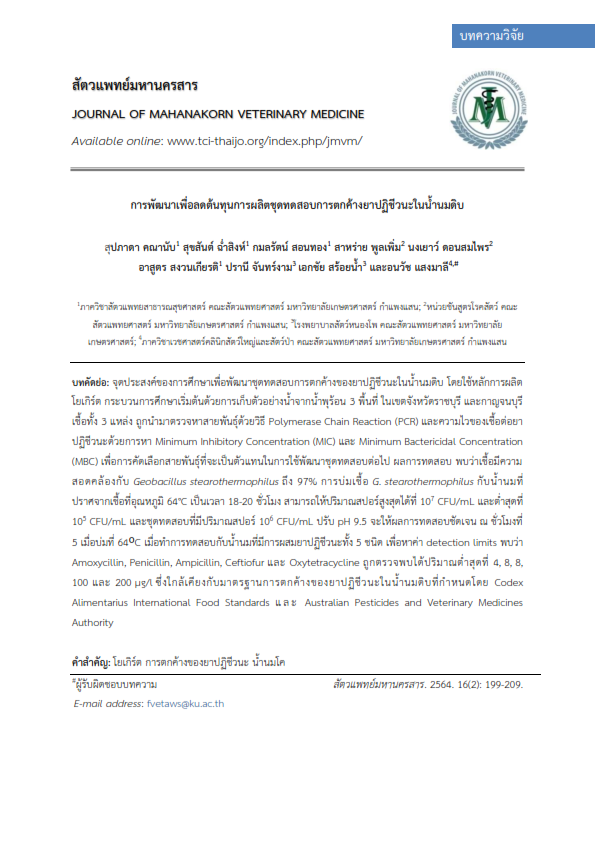Development for Reducing the Cost of Antibiotic Residue Test Kit
Main Article Content
Abstract
This study was to develop the test kit for detecting antibiotic residuals in raw milk, using the principle of yogurt producing. Water samples were collected from three hot springs located in Ratchaburi and Kanchanaburi province. After purification, species of microbes were identified by Polymerase Chain Reaction (PCR). DNA sequencing presented about 97% similarity of all samples to Geobacillus stearothermophilus. Three isolates were conducted Minimum Inhibitory Concentration (MIC) and Minimum Bactericidal Concentration (MBC) that the data from MIC and MBC used to support the selection for further steps. The conditions of stock preparation were 64°C of incubation for 18-20 hours produced the maximum spore of 107 CFU/mL and the minimum spore of 105 CFU/mL. The test kit consisted of 106 CFU/mL of G. stearothermophilus spore adjusted pH 9.5 and used bromocresol purple as a pH indicator could detect antibiotic residual at 5 hours of 64 ͦ C of incubation. Detection limits of Amoxicillin, Penicillin, Ampicillin, Ceftiofur, and Oxytetracycline were 4, 8, 8, 100, and 200 µg/l, respectively. The detection limits from the developed test were close to the standard of Codex Alimentarius International Food Standards and Australian Pesticides and Veterinary Medicines Authority.
Article Details

This work is licensed under a Creative Commons Attribution-NonCommercial-NoDerivatives 4.0 International License.
References
Australian Pesticides and Veterinary Medicines Authority (APVMA). 2017. Agricultural and Veterinary Chemicals Code Instrument No. 4 (MRL Standard) 2012: 283 pages.
Guizelini, B.P., L.P.S. Vandenberghe, S.R.B.R. Sella, C.R. Soccol. 2012. Study of the influence of sporulation conditions on heat resistance of Geobacillus stearothermophilus used in the development of biological indicators for steam sterilization. Arch Microbiol. DOI 10.1007/s00203-012-0832-z.
Burgess, S. 2016. Characterisation of dairy strains of Geobacillus stearothermophilus and a genomics insight into its growth and survival during dairy manufacture. PhD thesis. Massey University. New Zealand. 248 pages.
Burgess, S.A., S.H. Flint, D. Lindsay, M.P. Cox, and P.J. Biggs. 2017. Insights into the Geobacillus stearothermophilus species based on phylogenomic principles. BMC Microbiology. 17(140): 1-12.
Chinpan, K. 2003. Development of microbiological test kit for detection of antibiotic residues in milk. MS Thesis. Chulalongkorn University, Bangkok. (in Thai)
Codex Alimentarius International Food Standards (CIAFS). 2018. Maximum residue limits (MRLs) and risk management recommendations (RMRs) for residues of veterinary drugs in foods CX/MRL 2-2018: 46 pages.
Coorevits, A., A.E. Dinsdale, G. Halket, L. Lebbe, P.D. Vos, A.V. Landschoot, and N.A. Logan. 2012. Taxonomic revision of the genus Geobacillus: emendation of Geobacillus, G. stearothermophilus, G. jurassicus, G. toebii, G. thermodenitrificans and G. thermoglucosidans (nom. corrig, formerly ‘thermoglucosidasius’); transfer of Bacillus thermantarcticus to the genus as G. thermantarcticus comb. nov.; proposal of Caldibacillus debilis gen. nov., comb. nov.; transfer of G. tepidamans to Anoxybacillus as A. tepidamans comb. nov.; and proposal of Anoxybacillus caldiproteolyticus sp. nov. Int J Syst Evol Microbiol 62: 1470–1485.
Department of Livestock Development (DLD). 2010. Standard methods for the examination of dairy products. Bangkok. Thailand. (in Thai)
Gaudin, V. 2017. State of the art in the validation of screening methods for the control of antibiotic residues: is there a need for further development?. Food Addit Contam Part A 34(9): 1528–1552.
Gondová, Z., I. Kožárová, Z. Poláková, and M. Mad’arová. 2014. Comparison of four microbiological inhibition tests for the screening of antimicrobial residues in the tissues of food-producing animals. Ital J Anim Sci 13(3521): 728-734.
Stephen L.A.H. and J. Faragher. 2012. Validation of the Delvotest SP NT DA Performance Tested MethodSM 011101. Journal of AOAC International. 95(1): 252-259.
Jayalakshmi, K., M. Paramasivam, M. Sasikala, and A. Sumithra. 2017. Review on antibiotic residues in animal products and its impact on environments and human health. J Entomol Zool Stud 5(3): 1446-1451.
Kirchman, D.L., L. Yu, and M.T. Cottrell. 2003. Diversity and abundance of uncultured cytophaga-like bacteria in the Delaware Estuary. Appl Environ Microbiol 69(11): 6587–6596.
Kotzekidou, P. 2014. Geobacillus stearothermophilus (Formerly Bacillus stearothermophilus). Encyclopedia of Food Microbiology 1: 129-134.
National Bureau of Agricultural Commodity and Food Standards (NBACFS). 2017. Guidance in the application of Thai agricultural standard: good manufacturing practices for milk collection center. Ministry of Agriculture and Cooperatives. (in Thai)
Novik G., V. Savich, and O. Meerovskaya. 2018. Geobacillus bacteria: potential commercial applications in industry, bioremediation, and bioenergy production. In: Growing and handling of bacterial cultures. 36 pages.
Phiriyayon. S., W. Jantaramongkon, and S. Aimhun. 2016. Development of test kit for antibiotic determination in animal feed production by microbiological assay. BQCLP E-JOURNAL. 8(1): 266-296. (in Thai)
Priyanka, S. Panigrahi, M. Sheoran, and S. Ganguly. 2017. Antibiotic residues in milk- a serious public health hazard. J Environ Life Sci 2(4): 99-102.
Rueda, T.R. 2015. Evaluation of false positive results in microbial inhibitor tests for screening antibiotics in goat milk. Ph.D. Thesis. Universitat Politècnica de València. Spain. 196 pages.
Sumpradit, N., S. Suttajit, S. Poonpolsub, R. Chuanchuen, and P. Prakongsai. 2015. Landscape of antimicrobial resistance situation and action in Thailand. 1st ed. Bangkok: Aksorn Grphic and Design Publishing Limited Partnership. 143 pages. (in Thai)
Suriyasathaporn W., V. Chupia, T. Sing-Lah, K. Wongsawan, R. Mektrirat, and W. Chaisri. 2012. Increases of antibiotic resistance in excessive use of antibiotics in smallholder dairy farms in northern Thailand. Asian-Australasian J Anim Sci 25(9): 1322-1328.
Tangmunkhong, P., S. Viriyarampa, S. Cumsing, and P. Jala. 2007. New test kit for detection antibiotic residue in milk. Proceedings of the 45th Kasetsart University Annual Conference: Animals and Veterinary Medicine, Bangkok, Thailand. 30 Jan - 2 Feb 2007: 458-463. (in Thai)
Yamaniu, M.I., L.M.A. Al-Kurd, M.S.Y. Haddadi, and R.K. Robinson. 1999. A simple test for the detection of antibiotics and other chemical residues in ex-farm milk. Food Control 10: 35-39.
Yazdany, S. and K.B. Lashkari. 1975. Effect of pH on sporulation of Bacillus stearothermophilus. Appl Microbiol 30(1): 1-3.


